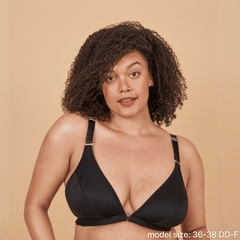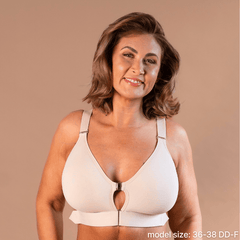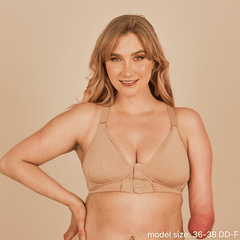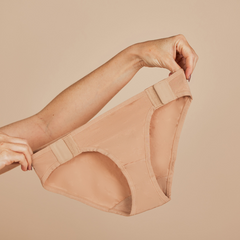Caitlin Barry, OTR/L , MSOT, is an occupational therapist dedicated to addressing issues surrounding sex and intimacy, particularly among those with disabilities and chronic illnesses. She is passionate about breaking down barriers in regards to topics related to menstrual health.
For those of us with Ehlers-Danlos syndrome (EDS), a connective tissue disease characterized by joint laxity and subsequent musculoskeletal complications, managing menstrual care can present a host of challenges.
Particularly for those that have limited hand or upper extremity function, period products can cause increased difficulty and stress. They require significant pinch strength and dexterity, and the ability to achieve awkward positions that place joints at risk for tendinitis.
It’s a vicious cycle as the increased physical stress and the possibility of further aggravating symptoms can all lead to exhaustion and emotional stress. And these are challenges faced not only by people with EDS, but also by people with a number of different conditions, such as rheumatoid arthritis, tendinitis, cerebral palsy, or neuromuscular disorders.
Below are some examples of principles to keep in mind if you have Ehlers-Danlos syndrome or other conditions affecting your hands or wrists as well as some innovative products to look out for!
1. Joint protection

This basically involves the concept of protecting smaller vulnerable joints like those in your thumb and fingers and using bigger joints to do the job. For example, using a gross grasp (i.e. your entire hand and fingers) instead of a pinching motion.
In the case of period management, this could mean if you are using a disposable pad, use one without wings because it puts more strain on fingers to remove the adhesive wings. Additionally, tampons require significant grip strength and not only place strain on the smaller joints, but the awkward position of wrist flexion combined with pinch can irritate conditions, such as DeQuervains tenosynovitis and make you more susceptible to tendonitis if you are prone to those conditions.
A game changing product for some might be an innovative new product called TINA, which is a tampon insertion device. This was created by a company that recognized the need for a new product to make a tampon easier to insert for those with physical disabilities.
It basically allows you to use a bigger grasp with a large handle to insert a tampon at the correct angle. This eliminates the need to pinch with fingers while pushing the applicator and having the wrist bent.
The applicator also has a handy notch for the string of the tampon for removal thus eliminating the strength and dexterity typically needed to pinch and pull the string. This can provide extra reach if reaching is an issue. If you need a caregiver to help you insert a tampon, the product can also provide a little distance between your body.
In general, when using the principles of joint protection you do want to be careful that you are not creating abnormal compensatory movement patterns. An OT or PT with experience in neuromuscular education can help.
2. Energy conservation

It goes without saying that each individual is unique and there can be a huge spectrum in the severity of symptoms with EDS. That being said, for those living with chronic illness there is often a need to conserve “energy" when navigating daily tasks.
In other words, you may only have so much strength and if you expend a lot of that energy on one task then your muscles may fatigue making you more prone to injury as your muscles tire.
With hypermobility, your muscles are protecting your joints since your ligaments and tendons aren't able to provide the strength they need. When those muscles become tired, you may become prone to joint injury.
During your period, you may want to strategize a bit depending on what your schedule looks like that day, how you are feeling, what environment you'll be in, or how heavy your cycle is that day.
For example, if tampons are difficult for you, maybe you only use them on your heaviest days and then you switch to period underwear on your other days. Or if you know you have to drive somewhere and that is taxing on your hands, use whatever product will strain your hands the least that day.
3. Period products pros, cons and adaptations
Disposable pads
Pro: they can be good for those without the strength to rinse out period underwear or insert a tampon.
Con: the adhesive can be difficult to remove and packaging can be a challenge. They also tend to bunch up and move if you are sitting in a wheelchair.
Adaptation: Try using an easy open bag to store your pads rather than having to open each one each time. There are a number of tools available such as a package opener that you put on your finger to open boxes or there is no shame and asking for help if it is available to you.
Period underwear
Pro: period underwear is a great option in that you put it on like regular underwear and it absorbs a surprising amount. It has the added benefit of comfort and eliminates bunching and moving around like pads often do. There is also no pesky packaging after the initial purchase.
Con: the biggest challenge is the grip strength necessary to rinse them out.
Adaptation: some ideas to combat that include letting them run under high-pressure water, or taking them in the shower. If you have use of your feet, you can step on them to squeeze them out or ask for help with this step if it's available to you. Thinx is a brand that offers many options. Another brand called Modi Bodi offers period underwear with magnetic side closures which can be a great option for someone not able to stand.
Tampons and tampon insertion device
Pro: easy to find and carry, good for activities like swimming.
Con: as I mentioned, tampons require significant grip strength and strain smaller joints, which can irritate conditions.
Adaptation: external applicators. I tested the TINA applicator and it would be extremely helpful for someone who could manage a gross grasp, which allows for a more ergonomic movement.
Cups
Pro: Some come with a ring on the end which may allow for easier removal however you still need the dexterity and pinch to be able to insert. That being said, if this motion doesn't bother you it can be a good option for a reusable product that can last for a while without changing.
Con: period cups require a significant amount of dexterity and strength in order to facilitate pinching and inserting the cup.
4. Track your cycle

This may sound obvious, but tracking your cycle can be extremely helpful. By knowing your cycle, you’re better able to manage your cycle and plan your habits and routines.
In general, a typical cycle is around 28 days. The first day that you begin menstruating is the first day of your cycle. Approximately 28 days after that is when your next cycle would begin.
There is variability in what is normal for an individual but usually averages between 24 and 30 days between periods and can last anywhere from 3 to 8 days.
There are a lot of fancy apps out there, but make sure to check their privacy policies first. Alternatively, a simple dot on the calendar or a list on a piece of paper works fine too.
It can be helpful to track your cycle to identify any concerns or irregularities as well. Talk to your healthcare provider if you are concerned.
5. Period suppression

There are instances when it just becomes too overwhelming or even impossible to use period products to manage your period with EDS or other chronic conditions.
You can talk to your OB/GYN about possible hormonal suppression options and they should provide you with information on risks and benefits as well as what to expect.
Gynecologists should be familiar with the use of hormonal therapy for menstrual suppression, which includes options such as the combined oral contraceptive pills, combined hormonal patches, vaginal rings, progestin-only pills, depot medroxyprogesterone acetate, the levonorgestrel-releasing intrauterine device, and the etonogestrel implant.
It is important to be aware that many comorbidities may have contraindications for hormonal treatment options. Therefore, it is extremely important you provide your doctor with all of your history so that they can provide guidance in this area.
Periods and disabilities are something that has historically not been widely discussed or publicly recognized, but I have hope that it is slowly changing. Seeing new innovative products recognize where there is a gap in accessibility and a need for change is a step in the right direction.
Managing periods with EDS and chronic illness can be exhausting, so what can help make periods more manageable is having a supportive healthcare team, a tool kit with adaptive strategies and products, and listening to your body and mind as to what you need.




